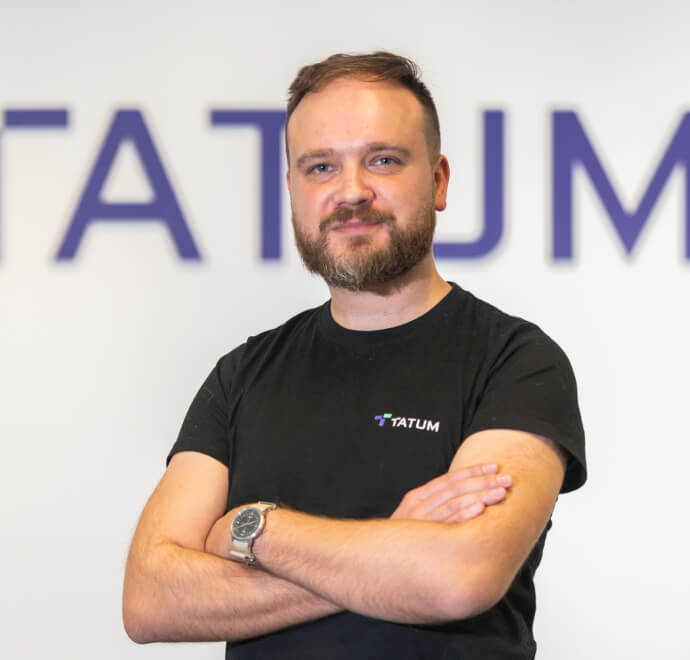Embark on a journey through the intricate world of Web3 with Mantas Ciuksys, VP of Content at Tatum, who brings a trove of knowledge from the summit of digital landscapes right to your ears.
Our reunion with Mantas is more than just a nostalgic trip; it's an expedition to the cutting edge of blockchain technology and marketing innovation. Discover how Tatum is revolutionizing the way blockchain applications are developed and making strides with giants like Binance. We tackle the challenge of demystifying Web3 jargon, focusing on the real-world problems that blockchain can solve, and the significance of crafting messages that resonate with a broad audience.
Let's unlock the secrets of content strategy that engage and retain, transforming every interaction into an opportunity to captivate your audience. Explore the artistry behind content that speaks to users at different stages of their journey, from the first spark of awareness to the thrill of purchase, and beyond. In the vast expanse of the Web3 universe, Tatum's success stories emerge from their robust GitHub community and thriving Discord server—testaments to the enduring power of a well-crafted website as the linchpin of user engagement and conversion.
As our conversation draws to a close, we celebrate the essential role of community in the Web3 narrative—a force that not only validates but empowers businesses and developers alike. Marketing in this realm is an adventure, with its own set of puzzles, like high ad-blocker usage and the intricacy of paid campaigns. But with the promise of blockchain-driven marketing innovations on the horizon, we're on the cusp of a new era. Gratitude abounds for Mantas and his insights, and we extend an open invitation to our listeners: join the conversation, share the knowledge, and become an integral part of the Web3 community's growth and success.

Mantas Ciuksys
Unlocking the Power of Web3: A New Frontier in Digital Innovation
Imagine stepping into a world where the internet is not just a space for browsing but a vibrant ecosystem powered by blockchain technology. This is Web3, a new phase of the internet that promises to revolutionize how we interact online, emphasizing decentralization, user sovereignty, and enhanced security.
In this exploration, we'll uncover the essence of Web3, from the critical role of communities in supporting projects to the innovative marketing strategies that are shaping its future. We'll see how Web3 is not just about technology but about building a more interactive and user-centric online world. Whether it's through the strategic use of content, navigating the challenges of marketing without traditional data, or leveraging unique channels like GitHub and Discord, Web3 is setting the stage for a digital revolution.
The impact of Web3 extends beyond just the tech-savvy; it has the potential to redefine online interactions for everyone. By fostering a space where communities thrive, content is king, and marketing strategies evolve, Web3 is not just the future of the internet—it's the future of how we connect, share, and grow together online.
Curious about how this all comes together? Stay tuned as we answer these questions and more, diving deep into the world of Web3 and its transformative potential.
The Importance of Community in Web3
The role of community in supporting a project is multifaceted and critical. In the dynamic and often complex world of Web3, a community does not merely represent a group of followers or users; it embodies the liveliness and the very essence that can propel a project forward. This community serves as the backbone, providing not just moral support but also contributing to the development and troubleshooting processes. It's a symbiotic relationship where the project offers value, and in return, the community champions its growth and sustainability.
The function of community in generating impressions and views is another pivotal aspect. A vibrant community ensures that the project remains in the limelight, attracting more users and developers through word-of-mouth, social media engagement, and various other channels. This organic growth mechanism is invaluable, especially in a space as competitive as Web3, where standing out from the crowd requires more than just innovative technology; it requires a loyal and engaged community.
The impact of a vibrant community on the validity of a business in Web3 is profound. Potential users, developers, and investors often gauge the credibility and potential of a project based on the activity and engagement within its community. A project with a lackluster or non-existent community might raise red flags, suggesting that it lacks the user base or developer support necessary for long-term success. Conversely, a thriving community signals a healthy, active, and potentially lucrative project.
The role of community in providing support and troubleshooting is indispensable. In the fast-paced and technically challenging environment of Web3, users and developers frequently encounter hurdles. A strong community acts as a first line of support, where members can share knowledge, offer solutions, and assist each other in overcoming challenges. This peer-to-peer support system not only enhances the user experience but also alleviates pressure on the project's official support team, allowing them to focus on more complex issues. Finding ambassadors within the community who can respond to queries sometimes even quicker than the official support team is a testament to the power and importance of community in Web3.
In essence, the community in Web3 transcends the traditional concept of a user base. It is a dynamic, interactive, and critical component of any project's success. From generating buzz and validating the business to providing invaluable support and fostering innovation, the community is at the heart of what makes Web3 unique and exciting. As such, nurturing and actively engaging with this community is not just beneficial but essential for projects looking to thrive in the Web3 ecosystem.

The Role of Content in Web3 Marketing
The value exchange between the user and the business through content is a fundamental aspect of Web3 marketing. Content serves as a bridge, connecting users with the business in a meaningful way. It's not just about broadcasting messages or pushing promotions; it's about offering something of value that resonates with the audience. This could be educational resources, insights into industry trends, or solutions to common problems faced by users. By providing valuable content, businesses can engage users in a deeper conversation, fostering trust and establishing themselves as thought leaders in their space.
The function of content in different stages of the business funnel is critical for guiding users through their customer journeys. From creating awareness at the top of the funnel to facilitating decision-making at the bottom, content plays a role at every step. At the awareness stage, content might focus on highlighting the problems that the business solves. As users move down the funnel, content can become more detailed, showcasing product features, benefits, and use cases. Finally, at the decision stage, content can help overcome objections and provide the final push towards conversion. This strategic use of content ensures that users receive the right information at the right time, making their path to conversion smoother and more intuitive.
The importance of measuring the effectiveness of content in Web3 marketing can't be overstated. Given the nascent nature of Web3 and the unique challenges it presents, understanding what content resonates with the audience is key. This involves tracking metrics such as engagement rates, website traffic, and conversion rates to gauge how well content is performing. However, it's also important to recognize the limitations of data in Web3, where privacy concerns and the decentralized nature of the technology can make detailed tracking difficult. Despite these challenges, businesses must strive to find a balance, using available data to inform their content strategies while respecting user privacy.
The role of content in attracting and retaining users is especially pronounced in the Web3 space, where education and community engagement are paramount. High-quality, informative content can attract users by demystifying complex topics and showcasing the practical applications of Web3 technologies. Once users are onboard, continued engagement through content can help retain them, encouraging loyalty and long-term participation. This could involve regular updates on project developments, community highlights, or educational series that deepen users' understanding of the technology. By consistently delivering content that adds value, businesses can build a strong, engaged user base that supports their growth and success in the Web3 ecosystem.
In conclusion, content is more than just words on a page or posts on social media; it's a strategic tool that plays a vital role in every phase of the user's relationship with a business. From attracting new users to nurturing and retaining them, content is at the heart of successful Web3 marketing strategies. By understanding the unique value exchange that content facilitates and tailoring strategies to meet users where they are, businesses can leverage content to achieve their goals and thrive in the dynamic world of Web3.
The Challenges and Strategies in Web3 Marketing
The difficulty in understanding customers in Web3 presents a unique challenge for marketers. Unlike traditional Web2 environments where customer data is readily available, Web3's emphasis on privacy and anonymity means that marketers often have limited information about their users. This lack of data can make it challenging to understand customer needs, preferences, and behaviors. In Web3, a user is typically represented by a wallet address, devoid of personal information like names or email addresses. This anonymity, while a cornerstone of the decentralized ethos, complicates efforts to tailor marketing strategies to individual users or segments.
The challenge of personalizing marketing in Web3 stems from this very anonymity. In a digital age where personalized marketing has become the norm, the inability to directly identify and communicate with users in Web3 can seem like a step backward. Traditional marketing strategies that rely on personalization to increase engagement and conversion rates face significant hurdles. For instance, sending a personalized email, a staple in digital marketing, becomes impossible without access to personal identifiers. This necessitates a shift in strategy, where marketers must find innovative ways to engage with their audience without relying on personal data.
The strategy of connecting the dots for trend lines becomes essential in navigating the murky waters of Web3 marketing. Without the ability to track individual users across their customer journeys, marketers must instead focus on identifying broader trends and patterns. This might involve analyzing aggregated data to understand how different segments interact with content or services. By piecing together these insights, marketers can form a picture of overall engagement and effectiveness, even if they can't attribute actions to specific users. This approach requires a shift from precision targeting to a more generalized understanding of audience behavior, but it can still yield valuable insights for refining marketing strategies.
The importance of getting comfortable with working in the dark is a reality that Web3 marketers must embrace. The lack of detailed customer data means that some aspects of marketing will inevitably involve educated guesses and assumptions. Marketers need to become adept at making decisions based on incomplete information, using whatever data is available to guide their strategies. This might mean accepting a higher degree of uncertainty in campaign outcomes or being prepared to adjust tactics on the fly as new information emerges. Embracing this uncertainty can be liberating, encouraging creativity and innovation in marketing approaches. Ultimately, success in Web3 marketing may come down to the ability to operate effectively even when the full picture remains elusive.
The Role of Different Channels in Web3 Marketing
The importance of the website in Web3 marketing can't be overstated. Despite the innovative nature of Web3 and its departure from traditional web paradises, the website remains a central hub for business activities. It's where potential users first encounter a brand, learn about its offerings, and decide whether to engage further. In the context of Web3, where direct communication with users is limited by design, a well-crafted website serves as a vital bridge between a business and its audience. It's not just about providing information; it's about creating an experience that resonates with visitors and encourages them to become part of the community or customer base. The website's role extends beyond a simple information portal to become a critical tool in building trust and credibility in a space where these qualities are highly valued.
The role of GitHub and Discord in building community highlights the unique dynamics of Web3 marketing. GitHub, known for hosting code and facilitating collaboration among developers, becomes a beacon for those looking to contribute to or understand the technical foundations of a project. It's a space where transparency and collaboration are not just encouraged but required, aligning perfectly with the ethos of Web3. Discord, on the other hand, offers a more dynamic and interactive platform where users, developers, and enthusiasts can engage in real-time discussions, share insights, and provide support to one another. These platforms are not just channels for communication; they are the very fabric of the community that supports and sustains Web3 projects. The vibrancy and engagement level of these communities can significantly impact the perception and success of a Web3 initiative, making them indispensable tools in the marketer's arsenal.
The impact of community on the success of a business in the Web3 space is profound. A strong, engaged community is not just a nice-to-have; it's often the lifeblood of a project. Community members serve as ambassadors, advocates, and sometimes even contributors, playing a critical role in spreading the word, providing feedback, and driving adoption. The sense of belonging and mutual support found within these communities can be a powerful motivator for participation and loyalty. For businesses, fostering a vibrant community is about more than just marketing; it's about building a foundation for sustained growth and innovation. The challenge lies in nurturing these communities in a way that feels authentic and inclusive, ensuring that every member feels valued and heard.
The challenges and strategies in using paid campaigns in Web3 marketing reflect the nuanced nature of the space. Paid campaigns, while a staple in traditional digital marketing, face unique hurdles in Web3. Issues such as ad blocking and the misclassification of ads due to crypto-related content restrictions can impede the reach and effectiveness of paid strategies. Moreover, the decentralized ethos of Web3 often favors organic growth and community-driven promotion over paid advertising. However, this doesn't mean that paid campaigns are off the table. When executed thoughtfully, they can complement organic efforts, helping to amplify messages and reach new audiences. The key is to approach paid campaigns with an understanding of the Web3 context, tailoring strategies to align with the values and preferences of the community. This might involve leveraging platforms that are friendly to Web3 content or finding creative ways to engage users beyond traditional ads. Despite the challenges, there's potential for paid campaigns to play a supportive role in a broader Web3 marketing strategy, provided they are used judiciously and in harmony with community-driven efforts.
The Limitations and Opportunities of Advertising in Web3
Ad blockers present a significant hurdle in the digital advertising world, especially within the Web3 ecosystem. The prevalence of ad blockers among developers and tech-savvy individuals is notably high, creating a challenging environment for marketers aiming to reach this audience. This tech-savvy demographic often employs ad blockers as a means to enhance their online experience by reducing distractions and protecting their privacy. Consequently, advertisers must rethink their strategies, acknowledging that traditional banner ads or pop-ups may not be effective. This scenario necessitates innovative approaches to capture the attention of a group that inherently resists conventional advertising methods.
Traditional advertising channels see limited use among Web3 businesses, indicating a shift in promotional strategies within this space. Observing the trends, it's apparent that few Web3 entities leverage platforms like pay-per-click (PPC) or Reddit advertising to a significant extent. This reluctance can be attributed to several factors, including the high incidence of ad blockers, as mentioned, and a general skepticism towards advertising within the community. When Web3 businesses do venture into paid advertising, they often encounter steep learning curves and challenges in achieving meaningful engagement. This has led to a cautious approach, where businesses experiment with limited budgets to gauge effectiveness before committing more substantial resources. The underlying principle is to ensure a tangible return on investment, adhering to the pragmatic view of spending a dollar to earn three.
Ensuring return on investment in advertising is a critical concern for Web3 businesses. The emphasis on measuring the effectiveness of each advertising dollar spent reflects a broader trend towards data-driven decision-making. In an ecosystem where resources are precious, and the audience's attention is fragmented, achieving a positive return on investment (ROI) becomes paramount. This approach encourages businesses to meticulously track their advertising efforts, fine-tuning strategies based on performance data. For instance, a Web3 company might experiment with different ad creatives, targeting options, and platforms, continuously optimizing to find the formula that yields the best ROI. This iterative process underscores the importance of agility and adaptability in Web3 marketing strategies.
Blockchain technology in marketing campaigns holds untapped potential, offering novel ways to engage with audiences and track campaign effectiveness. The idea of leveraging blockchain for marketing is not just about innovation for its own sake but about addressing some of the inherent challenges in Web3 advertising. For example, the use of wallets for messaging or the implementation of NFT gating mechanisms could provide more direct and meaningful ways to connect with users. These methods also offer the advantage of bypassing traditional ad blockers, reaching tech-savvy audiences in a manner that respects their preferences for privacy and control over their online experience. Moreover, blockchain's transparency and immutability can enhance trust in marketing campaigns, allowing businesses to verify the authenticity of interactions and transactions. As the industry matures, the integration of blockchain technology in marketing efforts could redefine how businesses engage with their communities, turning current limitations into opportunities for innovation and growth.
The Potential of Wallets in Web3 Marketing
Exploring wallet-based communication opens up a fascinating avenue for direct engagement in the Web3 space. The concept of utilizing wallets as a channel to message other wallets is not only innovative but also aligns with the decentralized ethos of Web3. This method of communication could revolutionize how businesses interact with their audience, offering a personalized and secure way to reach out. However, the practical application of this idea faces hurdles, primarily due to the lack of widespread adoption and standardized protocols that would allow for seamless wallet-to-wallet messaging. Despite these challenges, the potential for creating a more direct and meaningful connection with users who are already engaged with a business through their wallets is immense. It represents a frontier yet to be fully explored in digital marketing within the Web3 ecosystem.
Overcoming the challenge of customer reach through wallets is a significant concern for businesses operating in the Web3 domain. Given the nature of blockchain technology and the privacy it affords, reaching customers who interact with a business solely through their wallets presents a unique set of challenges. Traditional marketing channels often rely on the ability to collect and analyze user data to tailor communications, an approach that is less straightforward in the decentralized world of Web3. This limitation necessitates innovative thinking and the development of new tools and methodologies that respect user privacy while still enabling effective engagement. The quest for solutions that facilitate meaningful interactions without resorting to intrusive practices, like unsolicited airdrops, is ongoing. Businesses are keenly interested in any advancements that would allow them to bridge this gap effectively.
Verifying user credibility through wallets offers a promising solution to several challenges faced by Web3 marketers. The anonymity and pseudonymity inherent in blockchain technology can complicate efforts to understand and engage with an audience. However, leveraging wallets for user verification and credibility checks could provide a way forward. This approach could help mitigate issues such as bot traffic, ensuring that marketing efforts are directed towards genuine users. The concept of NFT gating or similar mechanisms, where access to certain content or services is contingent upon holding a specific NFT, exemplifies how blockchain technology can be used to verify user identity and engagement in a privacy-preserving manner. As these practices gain traction, they could significantly enhance the effectiveness of marketing campaigns by ensuring that communications are targeted at verified, interested users.
The need for broader adoption and functionality of wallets in Web3 businesses is clear. While the potential of wallets in marketing is vast, realizing this potential requires more widespread adoption and enhanced functionality. The current state of wallet technology often focuses on transactions and asset management, with less emphasis on communication and user engagement features. For wallets to become a cornerstone of Web3 marketing strategies, they must evolve to include functionalities that support direct messaging, user verification, and other engagement tools. This evolution would not only benefit marketers but also enhance the overall user experience by making wallet interactions more versatile and meaningful. As the Web3 ecosystem continues to grow, the development and adoption of more sophisticated wallet technologies will be key to unlocking the full potential of digital marketing in this new frontier.
The Impact of Market Sentiment and Regulation on Web3 Adoption
The hesitation of businesses due to regulatory uncertainties is a significant barrier to the broader adoption of Web3 technologies. This hesitation stems from a complex regulatory environment that varies significantly across different jurisdictions. For many businesses, especially those operating in or targeting the United States, the lack of clear guidelines on the use of cryptocurrencies and blockchain technology creates a challenging scenario. Companies are often left to interpret vague regulations, leading to a cautious approach towards integrating Web3 technologies into their operations. This cautiousness is not unfounded, as the potential legal ramifications of non-compliance can be severe, including hefty fines and legal disputes. Consequently, businesses find themselves in a predicament, weighing the innovative potential of Web3 against the uncertain regulatory backdrop.
The influence of market sentiment on the readiness of Web3 technology further complicates the situation. Market sentiment can be incredibly volatile in the cryptocurrency and blockchain space, with public perception swinging dramatically in response to news, trends, and developments. This volatility affects not only investment and trading but also the willingness of businesses to adopt Web3 technologies. When market sentiment is positive, companies may feel more inclined to invest in and integrate these technologies, anticipating a favorable reception from consumers and investors. Conversely, during periods of negative sentiment, the perceived risk may outweigh the potential benefits, leading to a slowdown in adoption. This sensitivity to market sentiment underscores the nascent and evolving nature of the Web3 ecosystem, where confidence can significantly impact technological readiness and adoption rates.
The challenge of accepting crypto payments and connecting wallets to websites is another practical hurdle for businesses exploring Web3 integration. Accepting cryptocurrency as a form of payment or enabling wallet connections on a website introduces a host of technical and operational considerations. From ensuring secure transactions to managing the volatility of cryptocurrency values, businesses must address several complexities. Moreover, integrating wallet functionality into websites is not just a technical challenge but also a strategic one, as it requires careful consideration of user experience and privacy. The decision to enable such features often involves a thorough risk assessment, weighing the benefits of increased engagement and accessibility against the potential for security vulnerabilities and regulatory scrutiny.
The need for risk assessment in adopting blockchain technology in marketing is paramount. As businesses contemplate leveraging blockchain for marketing purposes, conducting a detailed risk assessment becomes an essential step. This assessment should consider various factors, including regulatory compliance, technological readiness, market sentiment, and the potential impact on brand reputation. By carefully evaluating these aspects, businesses can make informed decisions about incorporating Web3 technologies into their marketing strategies. The goal is to harness the innovative potential of blockchain and cryptocurrencies while mitigating risks and navigating the regulatory and market challenges that currently hinder widespread adoption. As the Web3 ecosystem matures and regulatory frameworks become more defined, businesses may find it easier to assess and manage these risks, paving the way for more robust and effective blockchain-based marketing initiatives.
The Evolution and Future of Web3 Businesses
The growing professionalism and long-term thinking in Web3 businesses mark a significant evolution in the industry. Initially characterized by rapid growth and a focus on quick gains, the Web3 sector is witnessing a shift towards more strategic and sustainable approaches. This change is evident in the increasing number of businesses adopting professional standards and practices, from structured project management to strategic planning. Moreover, there's a noticeable trend of companies looking beyond the immediate horizon, setting goals that span five to ten years into the future. This long-term thinking is not just about surviving the next market cycle but about building foundations that will support sustained growth and innovation. By focusing on professionalism and future-oriented strategies, Web3 businesses are positioning themselves to play a pivotal role in the broader tech ecosystem.
The shift from immediate value to sustainable future in Web3 projects reflects a maturation within the industry. The early days of Web3 were marked by stories of overnight success and rapid wealth accumulation, which, while exciting, did not necessarily contribute to long-term stability or growth. Today, the narrative is changing. More Web3 projects are prioritizing sustainability over instant gratification, recognizing that true success lies in creating value that lasts. This shift is driven by a deeper understanding of the market and a commitment to building technologies and services that have a lasting impact. By focusing on sustainability, these projects are not only ensuring their own future but are also contributing to the stability and growth of the entire Web3 ecosystem.
The impact of market conditions on the size and efficiency of Web3 businesses is a critical factor in their evolution. Market downturns, while challenging, have prompted many Web3 companies to reassess their operations and focus on efficiency. In some cases, this has led to layoffs, which, although difficult, have helped businesses right-size their operations. This process of adjustment is not just about cutting costs but about strategically aligning resources with long-term goals. By becoming more efficient, Web3 businesses can better withstand market volatility and position themselves for sustainable growth. This resilience is essential for navigating the unpredictable nature of the Web3 market and for building businesses that can adapt and thrive in changing conditions.
The importance of community engagement and developer involvement in Web3 businesses can't be overstated. The Web3 ecosystem thrives on collaboration and open innovation, with communities and developers playing a central role. Engaging with these groups is not just a way to build support for a project; it's a strategy for driving innovation and growth. Communities provide valuable feedback and ideas, while developers contribute their technical skills to improve and expand Web3 platforms and services. By fostering strong relationships with these groups, Web3 businesses can tap into a wealth of knowledge and creativity, fueling their development and ensuring their relevance in a rapidly evolving market. This emphasis on community and developer engagement is a hallmark of the Web3 industry, distinguishing it from more traditional sectors and highlighting its collaborative and inclusive nature.
Wrapping It Up
As we conclude, it's clear that the Web3 ecosystem is a vibrant and evolving space, characterized by its emphasis on community, innovation, and a forward-thinking approach. Here are the key takeaways:
The critical role of community in driving the success and sustainability of Web3 projects, highlighting the symbiotic relationship between projects and their supporters.
The strategic use of content and marketing in Web3, which must adapt to the unique challenges of privacy, anonymity, and decentralized ethos inherent in the ecosystem.
The evolving nature of Web3 businesses, which are increasingly focusing on long-term sustainability, efficiency, and the importance of engaging with their communities and developers.
With these insights, one might wonder, how will the balance between user privacy and effective marketing evolve in the Web3 space? Until we meet again, let's ponder on this evolving dynamic.

Mantas Ciuksys on the Web3 CMO Stories podcast
KEY HIGHLIGHTS
[01:34] Could you briefly introduce yourself in about a minute?
[02:59] Can you provide an overview of Tatum's platform and how it streamlines blockchain application development for Web3?
[04:41] What does the marketing strategy for Tatum look like, and what unique approaches do you think are effective for promoting blockchain development through Tatum's platform?
[08:06] Are you implementing strategies similar to combining data, free domain names, and social media targeting to identify and reach potential users/consumers, as discussed by other guests on the podcast?
[09:47] How do you approach content creation with your audience in mind, especially from the perspective of your VP of Content?
[14:03] What are the most popular channels Tatum utilizes for content distribution?
[15:31] How does Tatum utilize community building, especially in comparison to Web2's centralized approach?
[17:45] Does Tatum employ a combination of organic growth strategies and paid advertising campaigns to expand its reach, and if so, to what extent?
[20:40] How can blockchain technology be utilized effectively in marketing campaigns?
[22:54] How can blockchain wallets potentially provide a solution for challenges related to cookies and remarketing on websites, particularly in terms of privacy and user control over data sharing?
[24:16] What excites you most about being in the content industry in Web3 right now?
NOTABLE QUOTES
“I come from the world of Web2 and I've worked in multiple different businesses... eventually I thought to do something crazy and went into Web3 and don't regret it at all.”
“What are people actually trying to solve? What is the problem that they're trying to solve with this specific solution?”
“Content is kind of a way to, it's a value exchange between the user in the other end and the business.”
“For us, that part of community is critical, that's business critical. The acquisition part we're able to solve in multiple different ways. But that support part is just community.”
“I think there's maturity that I'm definitely seeing and that's exciting for me.”
MENTIONED RESOURCES
Tatum: https://tatum.io/
CONNECT






